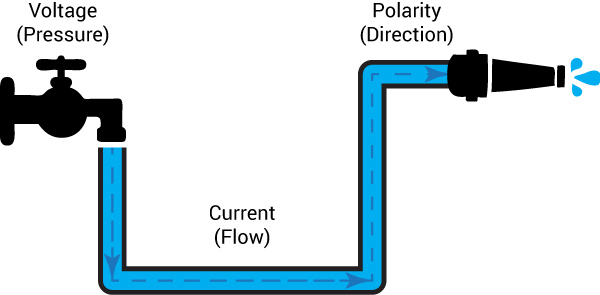Electricity Water Hose Analogy

The electronic hydraulic analogy derisively referred to as the drain pipe theory by oliver lodge is the most widely used analogy for electron fluid in a metal conductor since electric current is invisible and the processes in play in electronics are often difficult to demonstrate the various electronic components are represented by hydraulic equivalents.
Electricity water hose analogy. Voltage is like the pressure that pushes water through the hose. In a direct current dc electrical circuit the voltage v in volts is an expression of the available energy per unit charge which drives the electric current i in amperes around a closed circuit. The flow of water can be analogous to the amperage of current which is the rate of flow of charge. You can increase the power generated by the waterwheel in two ways.
You can have a small pipe with high pressure or a large pipe with low pressure each passing. The analogy here is to water flow or more specific the amount of water flowing through a cross sectional area per unit time. Water pressure for voltage. Electricity 101 voltage current and resistance.
I use a water hose as a conductor. Think of how fast and how much water is flowing out of your hose. Water flow to show current. Take a hose and point it at a waterwheel like the ones that were used to turn grinding stones in watermills.
Dc circuit water analogy this is an active graphic. As the name implies it resists the flow of electricity. So here it is. We think it does a great job of explaining electricity in really straightforward terms with an imaginative use of a water pump as an analogy.
But using water as an analogy offers an easy way to gain a basic understanding. In general terms charge is water voltage is the pressure of water current is the flow of the water. It was used by the physicists at a state s iso independent systems operator that oversaw the reliability of the state s electricity grid to explain how they route electricity to ensure power flows where needed. The best analogy is usually the stream of water.
The three most basic components of electricity are voltage current and resistance. The fundamental laws of electricity are mathematically complex. Power is the total amount of water flowing in given time. Electricity explained intro for a long time folks have been wrestling to come up with a comprehensive analogy for basic electrical terms and functions.
The water analogy is a fitting introduction. The water hose analogy for electricity is useful for explaining voltage current and power. If you have ever heard of the term ohm that is resistance.

















